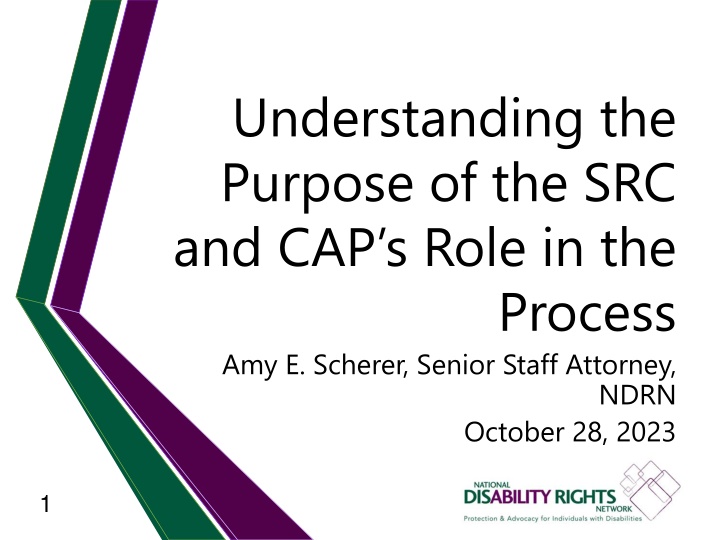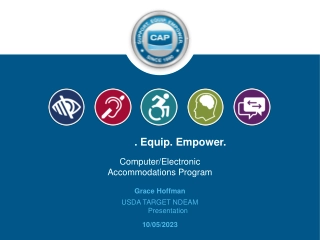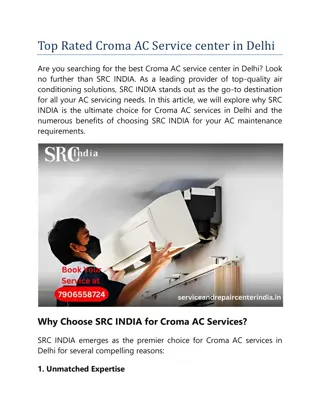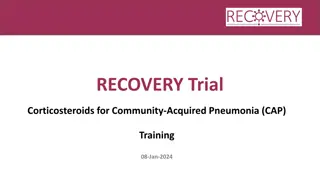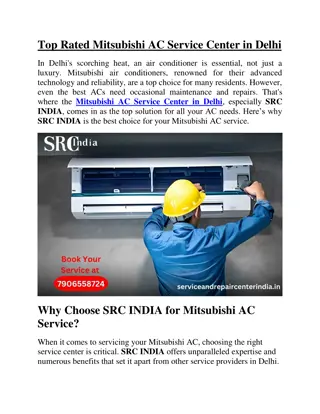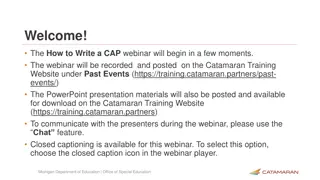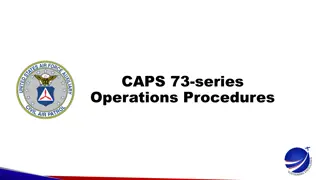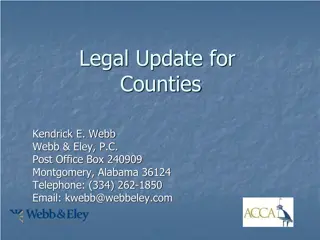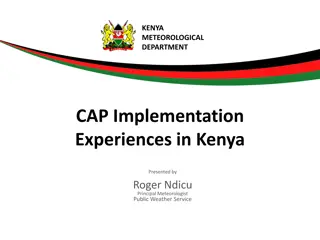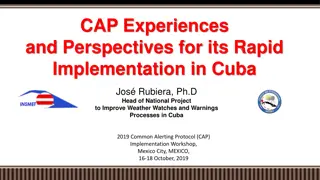The Role of SRC and CAP
State Rehabilitation Councils (SRC) play a crucial role in advising Vocational Rehabilitation agencies, ensuring stakeholder voices are heard, and evaluating program effectiveness. CAP representatives have essential membership requirements within SRC. Learn about SRC functions, obstacles faced by members, and more in this informative presentation by Amy E. Scherer, Senior Staff Attorney at NDRN.
Download Presentation

Please find below an Image/Link to download the presentation.
The content on the website is provided AS IS for your information and personal use only. It may not be sold, licensed, or shared on other websites without obtaining consent from the author.If you encounter any issues during the download, it is possible that the publisher has removed the file from their server.
You are allowed to download the files provided on this website for personal or commercial use, subject to the condition that they are used lawfully. All files are the property of their respective owners.
The content on the website is provided AS IS for your information and personal use only. It may not be sold, licensed, or shared on other websites without obtaining consent from the author.
E N D
Presentation Transcript
Understanding the Purpose of the SRC and CAP s Role in the Process Amy E. Scherer, Senior Staff Attorney, NDRN October 28, 2023 1
Learning Objectives At the conclusion of this presentation, attendees will be able to describe at least three functions of the SRCs. At the conclusion of this presentation, attendees will be able to explain at least three specific obstacles that SRC members may face as well as at least three potential solutions. At the conclusion of this presentation, attendees will be able to list the CAP s SRC membership requirement and explain CAP s advocacy role. 2
State Rehabilitation Councils (SRC) Established in Section 105 of the Rehabilitation Act of 1973, as amended by WIOA and 34 CFR 361.16-361.17 of its implementing federal regulations. The SRC gives advice to and works in partnership with the Vocational Rehabilitation (VR) agencies/units. If there are 2 separate VR agencies (e.g. General/Blind), the state has the option of establishing separate SRCs. 3
SRC: Composition, Membership and Mandated Requirements (1) At least one representative of the Client Assistance Program (CAP) must be on the SRC the CAP Director or another individual recommended by the CAP. Members appointed by the Governor with 3- year term limits and for no more than two consecutive terms, though the 2-term limit does not apply to the CAP representatives. 4
Changes to the SRC under WIOA In a State in which one or more projects are funded under section 121 (the Native American VR program), at least one representative of the directors of the projects located in such State shall be represented on the SRC. 5
SRC: Composition, Membership and Mandated Requirements (2) The SRC ensures that the voice of community stakeholders is heard as VR agencies develop and implement policies and procedures that directly impact the individuals served by the VR agencies. 6
Functions of the SRC (1) Develop and review State goals and priorities; Evaluate the effectiveness of the VR program; Eligibility, including order of selection; Extent, scope and effectiveness of VR services; Functions performed by State agencies that affect the ability of individuals with disabilities to achieve an employment outcome. 7
Functions of the SRC (2) Conduct statewide needs assessments; Consult regularly regarding the development, implementation, and revision of State policies and procedures, and other VR related activities; 8
Functions of the SRC (3) Provide comments during the development of the VR Services Portion of the WIOA Unified or Combined State Plan; and VRTAC-QM CoP | VRTAC-QM Prepare and submit to the Governor and to RSA no later than 90 days after the end of the Federal fiscal year an annual report on the status of the VR program and make the report available to the public. 9
Obstacles and Potential Solutions Obstacle #1: Inconsistent Attendance at SRC Meetings/Quorum Not Reached Conduct virtual meetings to eliminate transportation difficulties 10
Obstacles and Potential Solutions Obstacle #1: Inconsistent Attendance at SRC Meetings/Quorum Not Reached Institute and enforce a formal attendance policy. Members who do not comply will not be able to stay on the SRC 11
Obstacles and Potential Solutions Obstacle #2: Hesitancy to provide negative feedback to the SRC because it is made up of current and former VR staff It is the responsibility of the CAP staff to advocate on behalf of VR applicants and VR clients. 12
Obstacles and Potential Solutions Obstacle #2: Hesitancy to provide negative feedback to the SRC because it is made up of current and former VR staff CAP authorized activities include: Upon request, assisting or advocating for the client or client-applicant by engaging in individual or systemic advocacy [34 CFR 370.4(a)(3)] 13
Obstacles and Potential Solutions Obstacle #2: Hesitancy to provide negative feedback to the SRC because it is made up of current and former VR staff SRC Member Requirements at least one representative of the Statewide Independent Living Council (SILC) who must be either the chairperson or another designee of the SILC; 14
Obstacles and Potential Solutions at least one representative of the Client Assistance Program (CAP) who must be either the CAP director or another individual recommended by the CAP; at least one qualified VR counselor with knowledge of and experience with the VR program, who serves as a nonvoting, ex officio member if he or she is employed by VR; at least one representative of community rehabilitation program service providers; 15
Obstacles and Potential Solutions four representatives of business, industry, and labor; representatives of disability advocacy groups: (a) representing a cross-section of individuals with physical, cognitive, sensory, and mental disabilities; and (b) representing individuals with disabilities who have difficulty representing themselves or are unable to represent themselves due to their disabilities; at least one former or current applicant for, or recipient of, VR services; 16
Obstacles and Potential Solutions at least one representative of the directors of AIVRS projects, if such projects are funded under section 121 of the Rehabilitation Act in the State; at least one representative of the State educational agency responsible for the public education of students with disabilities; and at least one representative from the State workforce development board. 17
Obstacles and Potential Solutions The majority of SRC members must be: individuals with disabilities; and not employed by VR 18
Obstacles and Potential Solutions Obstacle #3: VR not willing to allow CAP representatives to provide feedback Advocate for a CAP report at each meeting These reports should not be restricted (e.g. one CAP reported that their CAP rep was only allowed to provide feedback at every other meeting) unless the other SRC reps are similarly limited in their reports. 19
Obstacles and Potential Solutions Obstacle #3: VR unwilling to discuss or provide feedback about certain raised topics One CAP rep was told that the topic of unspent VR funds was off limits. Remind VR that one of the key underlying principles of the SRC is the collaborative relationship between VR and its SRC members. Perhaps include such info in the CAP reports 20
Obstacles and Potential Solutions Obstacle #4: The CAP representative is too aggressive at the SRC meetings It is the responsibility of CAP representatives, by the nature of their jobs, to advocate strongly on behalf of VR clients and VR applicants But, it can be done calmly and in a non-rude manner. 21
Obstacles and Potential Solutions Obstacle #4: The CAP representative is too aggressive at the SRC meetings Consider committees to allow for in-depth, structured discussions about critical topics. Require each SRC member to join at least one committee. The committees should submit feedback and specific recommendations in writing. This approach may help to de-escalate some of the tension that may exist. 22
Obstacles and Potential Solutions Obstacle #5: VR believes that the CAP is too aggressive and resolves everything by filing for fair hearings. The data shows that CAPs, as required, resolve the majority of the issues at the lowest level possible. The total number of fair hearings held in a given fiscal year is small. 23
Possible VR/SRC Idea: Awards to Businesses in Your State Entrepreneur Award New Business Partner Recognition Award Small Business Recognition Award Large Business Recognition Award ** Nebraska Example: Given to VR Employment Partners ** 24
Contact Information Amy Scherer, Senior Staff Attorney, NDRN amy.scherer@ndrn.org Thank you!! Any Questions?? 25
National Disability Rights Network 820 First Street, NE, Suite 740 Washington, DC 20002 202-408-9514 www.ndrn.org 26
